
Frank Lloyd Wright was an American architect, designer, writer, and educator.

The Solomon R. Guggenheim Museum, often referred to as The Guggenheim, is an art museum at 1071 Fifth Avenue between 88th and 89th Streets on the Upper East Side of Manhattan in New York City. It is the permanent home of a continuously expanding collection of Impressionist, Post-Impressionist, early Modern, and contemporary art and also features special exhibitions throughout the year. The museum was established by the Solomon R. Guggenheim Foundation in 1939 as the Museum of Non-Objective Painting, under the guidance of its first director, Hilla von Rebay. The museum adopted its current name in 1952, three years after the death of its founder Solomon R. Guggenheim.

Fallingwater is a house designed by the architect Frank Lloyd Wright in 1935 in the Laurel Highlands of southwest Pennsylvania, about 70 miles (110 km) southeast of Pittsburgh in the United States. It is built partly over a waterfall on Bear Run in the Mill Run section of Stewart Township, Fayette County, Pennsylvania. The house was designed to serve as a weekend retreat for Liliane and Edgar J. Kaufmann, the owner of Pittsburgh's Kaufmann's Department Store.

Broadacre City was an urban or suburban development concept proposed by Frank Lloyd Wright throughout most of his lifetime. He presented the idea in his book The Disappearing City in 1932. A few years later he unveiled a very detailed twelve-by-twelve-foot scale model representing a hypothetical four-square-mile (10 km2) community. The model was crafted by the student interns who worked for him at Taliesin, and financed by Edgar Kaufmann. It was initially displayed at an Industrial Arts Exposition in the Forum at the Rockefeller Center starting on April 15, 1935. After the New York exposition, Kaufmann arranged to have the model displayed in Pittsburgh at an exposition titled "New Homes for Old", sponsored by the Federal Housing Administration. The exposition opened on June 18 on the 11th floor of Kaufmann's store. Wright went on to refine the concept in later books and in articles until his death in 1959.

Unity Temple is a Unitarian Universalist church in Oak Park, Illinois, and the home of the Unity Temple Unitarian Universalist Congregation. It was designed by the American architect Frank Lloyd Wright, and built between 1905 and 1908. Unity Temple is considered to be one of Wright's most important structures dating from the first decade of the twentieth century. Because of its consolidation of aesthetic intent and structure through use of a single material, reinforced concrete, Unity Temple is considered by many architects to be the first modern building in the world. This idea became of central importance to the modern architects who followed Wright, such as Ludwig Mies van der Rohe, and even the post-modernists, such as Frank Gehry. In 2019, along with seven other buildings designed by Wright in the 20th century, Unity Temple was added to the UNESCO World Heritage List.

Kaufmann's was a department store that originated in Pittsburgh, Pennsylvania.
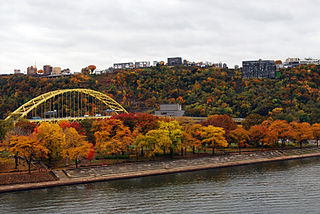
Point State Park is a Pennsylvania state park which is located on 36 acres (150,000 m2) in Downtown Pittsburgh, Allegheny County, Pennsylvania, USA, at the confluence of the Allegheny and Monongahela rivers, forming the Ohio River.

Edgar Jonas Kaufmann was an American businessman and philanthropist who owned and directed Kaufmann's Department Store, in Pittsburgh. He is also known for commissioning two modern architectural masterpieces, Fallingwater, designed by Frank Lloyd Wright and the Kaufmann Desert House in Palm Springs, designed by Richard Neutra.

The Waterfront is a super-regional open air shopping mall spanning the three boroughs of Homestead, West Homestead, and Munhall near Pittsburgh. The shopping mall sits on land once occupied by U.S. Steel's Homestead Steel Works plant, which closed in 1986. It has a gross leasable area of 700,000 square feet (65,000 m2) in "The Waterfront" and 400,000 square feet (37,000 m2) in "The Town Center." The development officially opened in 1999. More development continued into the early 21st century.

The Western Pennsylvania Conservancy (WPC) is a private nonprofit conservation organization founded in 1932 and headquartered in Pittsburgh, Pennsylvania. WPC has contributed land to 12 state parks and conserved more than a quarter million acres of natural lands. The Conservancy plants and maintains more than 132 gardens in 20 Western Pennsylvania counties, as well as planting thousands of trees through its community forestry program. WPC has protected or restored more than 3,000 miles (4,800 km) of rivers and streams. In 1963, Edgar Kaufmann Jr. entrusted Frank Lloyd Wright's masterwork Fallingwater to the Conservancy. The house was called the most important building of the 20th century by the American Institute of Architects.
Edgar Kaufmann Jr. was an American architect, lecturer, author, and an adjunct professor of architecture and art history at Columbia University.

The Gordon Strong Automobile Objective was a proposed planetarium, restaurant, and scenic overlook designed by American architect Frank Lloyd Wright for the top of Sugarloaf Mountain in Maryland. Wright developed the design in 1925 on commission from Chicago businessman Gordon Strong. A spiraling ramp featured centrally in Wright's plan; this was his first use of a feature which would later gain fame as part of his Guggenheim Museum in New York.
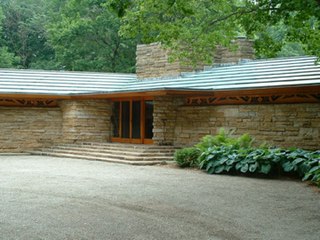
Kentuck Knob, also known as the Hagan House, is a house designed by the American architect Frank Lloyd Wright in rural Stewart Township near the village of Chalk Hill, Fayette County, Pennsylvania, USA, 45 miles (72 km) southeast of Pittsburgh. It was designated a National Historic Landmark in 2000 for the quality of its architecture.

The Plan for Greater Baghdad was a project done by American architect Frank Lloyd Wright for a cultural center, opera house, and university on the outskirts of Baghdad, Iraq, in 1957–58. The most thoroughly developed aspects of the plan were the opera house, which would have been built on an island in the middle of the Tigris together with museums and a towering gilded statue of Harun al-Rashid, and the university. Due to the 1958 collapse of the Hashemite monarchy, development of the project stopped, and it was never built.
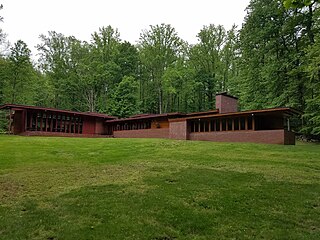
The James B. Christie House is a large, flat-roofed Usonian on a wooded site in Bernardsville, in Somerset County, New Jersey, United States. The Christie House, built in 1940, is Frank Lloyd Wright's oldest and, at 2,000 square feet (190 m2), Wright's largest house in New Jersey. The residence has one story and is made of brick, cypress, and redwood.
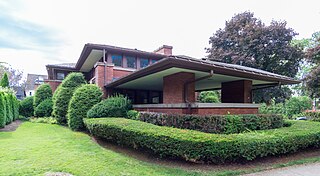
The William R. Heath House was designed by Frank Lloyd Wright, built from 1903 to 1905, and is located at 76 Soldiers Place in Buffalo, New York. It is built in the Prairie School architectural style. It is a contributing property in the Elmwood Historic District–East historic district and a City of Buffalo landmark.
Site-specific architecture (SSA) is architecture which is of its time and of its place. It is designed to respond to both its physical context, and the metaphysical context within which it has been conceived and executed. The physical context will include its location, local materials, planning framework, building codes, whilst the metaphysical context will include the client's aspirations, community values, and architects ideas about the building type, client, location, building use, etc.
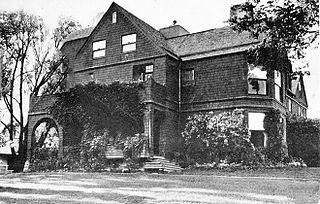
Hillside Home School I, also known as the Hillside Home Building, was a Shingle Style building that architect Frank Lloyd Wright designed in 1887 for his aunts, Ellen and Jane Lloyd Jones for their Hillside Home School in the town of Wyoming, Wisconsin. The building functioned as a dormitory and library. Wright had the building demolished in 1950.
Tasso Katselas is an architect in the United States known for his modernist concrete buildings especially in Pittsburgh, Pennsylvania. His work includes Pittsburgh International Airport, public housing, and mansions. His firm was known as Tasso Katselas Associates and became TKA when he semi-retired in 2005 while continuing to consult for the firm.
Paul Mayén was a Spanish architect and industrial designer known for his work at Frank Lloyd Wright's Fallingwater.




















